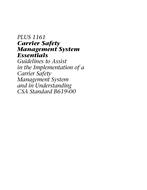CSA PLUS 1161 (1st ed. pub 2001)
Click here to purchase
This is a text searchable PDF.
1.
Introduction CSA Standard B619 (referred to from this point forward as #the standard# or #B619#) was developed to address the unique requirements of the trucking industry.
It was designed to provide assurances to stakeholders (such as insurance companies and federal and provincial regulators) that the carrier is committed to complying with all transportation safety requiremen ts.
The management of the carrier provides this assurance by establishing and implementing appropriate policies and procedures, setting safety performance objectives for the company, and continuously monitoring itself against these performance indicators.
Adherence to these policies should ensure that the safety and performance objectives are met and that all incidents of nonconformance with either a regulatory requirement or B619 are promptly identified and corrected.
This guide has been prepared with the intent to provide assistance to carrier organizations in implementing a Carrier Safety Management System (CSMS).
Many transportation or ganizations, through their participation on the Technical Committee on Carrier Safety Management Systems, provided industry-specific examples that are used in this guide.
The CSMS recognizes the importance of best management practices and principles in the development of a successful safety management culture.
The implementation of a CSMS in any organization should significantly assist the organization in realizing the benefits that can be derived from these practices which exceed the mandated performance requirements contained in legislation.
There are legislative and regulatory requirements, including those related to occupational health and safety, those related to the environment, and those of various federal and provincial transportation authorities that are not addressed directly in the standard or in this guide.
However, both the standard and this guide indicate where the requirements of federal and provincial road transportation authorities might be applicable.
The carrier organization should be aware of relevant legislation and fulfill regulatory requirements, using documented procedures where applicable, and these should become part of the carrier#s safety management system.
This guide also references complementary initiatives that have been implemented in the road transportation industry, such as the National Safety Code (in Canada) and the Commercial Vehicle Safety Alliance (CVSA) #out of service criteria# (used throughout North America).
The guide has been written for both small and large carrier organizations that provide road
transportation services.
It is designed to assist organizations that are considering the impleme ntation of a carrier safety management system.
It can also apply to businesses in which the movement of goods by road from one location to another is a component of the diversified business enterprise.
This guide is organized into three main parts:
an overview of the standard in Section 2; the rationale for implementing a CSMS in Section 3; and a detailed guide to the implementation of the individual clauses of the standard in Sections 4 to 7.
For convenience, the numbering of the clauses in Sections 4 to 7 is identical to the clause numbering in the standard.
This guide addresses each element of B619, and provides explanations, commentar ies, and helpful tips for implementation.
For convenience, the clauses excerpted from the standard are presented in boldface type, double indented, and are followed by explan ations and comments.
Helpful tips are provided in text boxes following the applicable clauses.
Product Details
- Published:
- 01/02/2002
- Number of Pages:
- 39
- File Size:
- 1 file , 210 KB
- Product Code(s):
- 2415698, 2414778, 2414778
